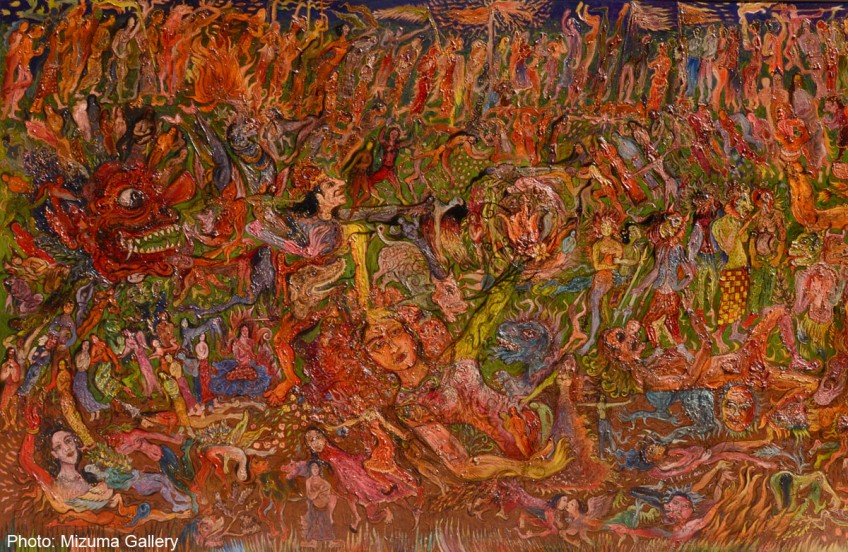Fermented In Indonesia


Mizuma Gallery's latest group show brings together some of the most exciting names of the contemporary Indonesian art scene.
The exhibition, titled Fermented In Indonesia, is related to the discovery and development of the contemporary art scene in the country.
Artworks on display reflect the cultural diversity and draw on local traditions as well as social and political conditions. Indonesian artists are known for their creative use of materials and strong statements. You get to see that in 10 major artworks ranging from paintings to installations.
Where: Mizuma Gallery, 22 Lock Road, 01-34, Gillman Barracks MRT: Labrador When: Till June 22, 11am - 7pm (Tue to Sat). 11am - 6pm (Sun). Closed on Mon & public holidays Admission: Free Tel: 6570-2505 Info: www.mizuma.sg
1 CORAL REEF, 2011
By Made Wianta, oil, acrylic on canvas, 210x310cm
Wianta's Coral Reef gives his insights into the current condition of our planet.
Coral reefs are a crucial part of the ecological balance that is being disturbed. The artist has made a name for himself for his creative use of materials - ranging from paint and fabrics to razor blades - to comment on the ecological challenges we face. Born in Tabanan as the youngest of 10 children, the artist grew up in a musical and artistic household.
2 FLYING ANGELS, PART OF CIVILIZATION ODDNESS SERIES, 2014
By Heri Dono, mixed media, 160x170x20cm
Artist Heri Dono has always used angels to represent hope and freedom in his works. Political violence and cultural clashes in modern society are recurring themes in his art. Merging elements of storytelling, mythology, humour and music, his armless angels appear with red capes. He draws inspiration from wayang puppetry.
3 THE SPIRIT OF GUARDS, PART OF CIVILIZATION ODDNESS SERIES, 2014
By Heri Dono, mixed media, 160x100x65cm
This is the embodiment of spiritual guardians of the earth that protect humans from the cruelty of life and their own barbarism. The artist believes even though the human race has evolved, peace in the world remains a utopian dream.
Tapping on the rich Indonesian culture of myths and fables, his installations make references to the social and political realities in his country. His roots are in wayang kulit (shadow puppetry), which he studied with Sukasman, a famous Indonesian puppeteer, between 1987 and 1988.
The established artist is now a strong supporter of younger artists.
4 MYSTIQUE ABOUT THE MOON, 2014
By Nasirun, oil on canvas, 150x300cm
The Yogyakarta-based artist, whose art was most recently seen in the Singapore Biennale 2013, is known for his allegorical canvases that comment on social and cultural issues.
Drawing on the rich wayang kulit tradition, the artist, who is known for his paintings, installation and sculptural works, presents deeply layered artworks intended to mirror the complexities of his country.
In this painting, he draws upon themes from the Hindu epics - the Ramayana and the Mahabharata - to envision what it would take to go from periods of darkness to light.
5 BEGINNING - PERFECT ENEMY, 2013 PART OF UNTOLD STORIES SERIES
By Entang Wiharso, brass, resin, colour pigment, thread, 270x170cm
Leading Indonesian artist Wiharso's detailed installations often draw on everyday aspects of life. His intricate installations are a complex web of human forms and politically charged text. At first glance, the artworks look busy, but on closer examination, the viewer is drawn into a moving meditation on the human condition. These, the artist says, are meant to show how society, culture and politics are "tied in an intricate web".
6 TAMED DISMANTLED FERMENTED CONSUMED REPEAT, 2014
By indieguerillas, mixed media, various sizes
This artwork is a record of art collective indieguerillas' artistic journey. It is about the struggle of its generation to find its creative identity and its voice.
The collective combines the contemporary with the past, and uses superhero icons, draws on skateboard and mixes its art with narratives from wayang stories.
7 COCA-HAPPY, 2014
By Angki Purbandono, scanography, light box installation, 142x120x20cm
A prison stint for the illegal possession of marijuana in 2012 transformed Purbandono's art. While in prison, he started using discarded materials including torn strips from soap and shampoo sachets to create art.
Eight years ago, he started looking at materials differently and his time in prison compelled him to take this further by working with all the materials he could find. He has collected discarded Coca-Cola cans from around the world with the help of friends. Coca-Happy is the first piece in a series that looks at how multi-nationals impact the world.
8 GREEN HYPERMARKET, 2011-2012
By Edwin Roseno, Kodak Endura, metallic paper pressed on dbond, mounted acrylic 3mm, diameter 40cm (four pieces), diameter 60cm (three pieces)
Green Hypermarket is Roseno's continuing exploration of Indonesians' fondness for recycling disposables, such as plastic bottles and tin cans, and using them for various things including for growing plants. His series is a comment on environmental consciousness at a time when more of our food is processed.

This article was first published on May 23, 2014.
Get a copy of The Straits Times or go to straitstimes.com for more stories.